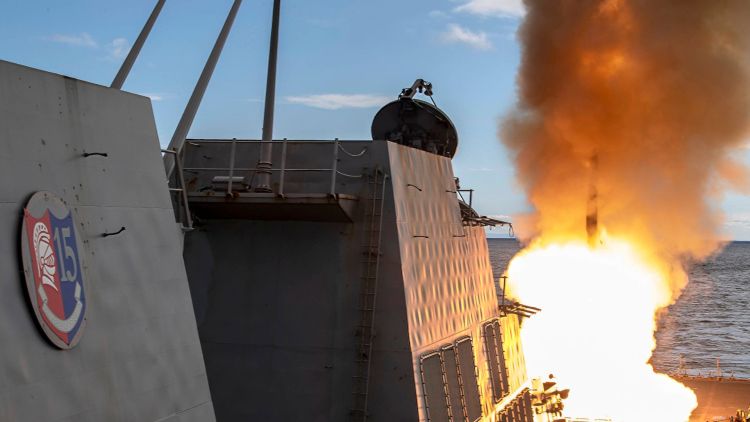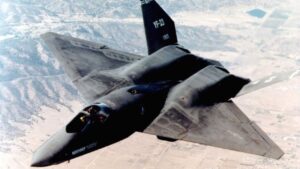The following piece first appeared on Warrior Maven, a Military Content Group member website.
The US Navy’s ongoing combat experiences in the Red Sea are helping the service further solidify emerging doctrinal approaches to maritime warfare, refine tactics, and identify emerging Concepts of Operation suitable for a modern threat environment.
There are many variables informing evolving military doctrine, such as multi-service autonomy, multi-domain and multi-national warfare, modern concepts of Combined Arms Maneuver for land war, new approaches to amphibious operations, and, of course, ubiquitous manned-unmanned teaming both across and between the services.
This transformation or maturation of military doctrine continues to be heavily influenced by US Navy Red Sea combat operations, as combat operations there have successfully implemented newer methods of networking, targeting, data sharing, and multi-node cross-domain combat integration. A Red Sea Commanding Officer of the US Navy’s Carrier Strike Group 2, Rear Adm. Javon “Hak” Hakimsadeh, told Warrior in an interview about his Carrier Strike Group’s Red Sea deployment.
“Doctrine is what allows us to set up within the Red Sea to be able to put in place command and control measures, airspace control measures or battle management areas or restricted operating zones to be able to manage the complexity of a multi-domain fight without spending a whole lot of time sorting things out,” Hakimsadeh, affectionately known as “Hak,” told Warrior.
Hak added specifics to these maturing doctrinal concepts of command and control, explaining that warship commanders in the Red Sea were able to “speak the same language” as forces in an Air Force Air Operations Center and Regional Air Operations Center. This kind of synergy helped streamline targeting, as inbound Houthi missiles and drone threats were successfully intercepted from the air on multiple occasions, Hak explained, adding, “We were able to establish standard command and control measures.”
“So doctrine is a thing that allows us to work outside our strike group. It allows us to work with our joint partners, say, in the Air Force or the Army. In this particular case, in the Red Sea example, [the] doctrine is what allowed us to go into a theater of operations, if you will, the Red Sea, that has been largely for the past three decades or so has been a pass-through force,” Hak explained to Warrior. “And then it’ll allow us to kind of structure multiple fights at the same time in multiple areas. A real shortcut that, you know, we train to all the time and, you know, likely again, saves a lot of heartache when you’re being shot at, if that makes sense.”
The following piece first appeared on Warrior Maven, a Military Content Group member website.
The US Navy’s ongoing combat experiences in the Red Sea are helping the service further solidify emerging doctrinal approaches to maritime warfare, refine tactics, and identify emerging Concepts of Operation suitable for a modern threat environment.
There are many variables informing evolving military doctrine, such as multi-service autonomy, multi-domain and multi-national warfare, modern concepts of Combined Arms Maneuver for land war, new approaches to amphibious operations, and, of course, ubiquitous manned-unmanned teaming both across and between the services.
This transformation or maturation of military doctrine continues to be heavily influenced by US Navy Red Sea combat operations, as combat operations there have successfully implemented newer methods of networking, targeting, data sharing, and multi-node cross-domain combat integration. A Red Sea Commanding Officer of the US Navy’s Carrier Strike Group 2, Rear Adm. Javon “Hak” Hakimsadeh, told Warrior in an interview about his Carrier Strike Group’s Red Sea deployment.
“Doctrine is what allows us to set up within the Red Sea to be able to put in place command and control measures, airspace control measures or battle management areas or restricted operating zones to be able to manage the complexity of a multi-domain fight without spending a whole lot of time sorting things out,” Hakimsadeh, affectionately known as “Hak,” told Warrior.
Hak added specifics to these maturing doctrinal concepts of command and control, explaining that warship commanders in the Red Sea were able to “speak the same language” as forces in an Air Force Air Operations Center and Regional Air Operations Center. This kind of synergy helped streamline targeting, as inbound Houthi missiles and drone threats were successfully intercepted from the air on multiple occasions, Hak explained, adding, “We were able to establish standard command and control measures.”
“So doctrine is a thing that allows us to work outside our strike group. It allows us to work with our joint partners, say, in the Air Force or the Army. In this particular case, in the Red Sea example, [the] doctrine is what allowed us to go into a theater of operations, if you will, the Red Sea, that has been largely for the past three decades or so has been a pass-through force,” Hak explained to Warrior. “And then it’ll allow us to kind of structure multiple fights at the same time in multiple areas. A real shortcut that, you know, we train to all the time and, you know, likely again, saves a lot of heartache when you’re being shot at, if that makes sense.”
It clearly makes sense to view Hak’s description of this kind of integrated “command and control” in terms of the Pentagon’s fast-emerging Joint All Domain Command and Control (JADC2) effort, a technological and conceptual initiative intended to enable, streamline and vastly improve multi-service connectivity. Led by Deputy Secretary of Defense Kathleeen Hicks, the JADC2 effort has been in the process of being implemented as a breakthrough Concept of Operation intended to enable a new-generation of higher-speed, multi-domain warfare. An ability to connect targeting data across otherwise separated regional areas and “fields of view” massively shortens sensor to shooter time, and in the case of the Red Sea, likely allowed warship commanders to see incoming Houthi attack with greater precision and at greater ranges.
The technological elements of JADC2 are varied as they integrate otherwise incompatible computer networks, information databases and transport layer communications technologies such as RF, GPS or other wireless datalinks. This is enabled by what Navy weapons developers call “interfaces,” meaning common standards and IP Protocol engineered to support the secure, seamless exchange of data.
Hubs or translators called “Gateways” are a big part of this, as they are small connecting devices which pool, organize, analyze and integrate incoming data from otherwise disconnected or separated transport layers. Perhaps a threat is first detected by a satellite system, Aegis radar or RF link from a drone or fighter jet? How does that targeting data get processed, verified and quickly transmitted to the optimal location so faster life-saving decisions can be made.
These processes are breaking through with speed, range and efficiency at an alarming rate, in large measure due to growing applications of increasingly secure artificial intelligence (AI).
While evidenced in this case with the US Navy and various air and space-sensors, the Red Sea’s combat synergies are helping efforts from different US military services come together, as intended by JADC2. Specifically, the Army’s Project Convergence and Integrated Battle Command System which massively shortened sensor-to-shooter time across domains using high-speed AI-enabled computing and transport layer interfaces.

The Air Force’s contribution, previously called Advanced Battle Management System, is merging technically with the Army’s networking and the Navy’s applications which were referred to as Project Overmatch. In each of these respective efforts, US military services sought to quickly and securely combine high-speed data aggregation and analysis across varied platforms and domains to enable US forces to operate faster than or “inside” of an enemy’s decision-making progress.
Sure enough, this seems to align with combat operations in the Red Sea, which Hak told Warrior very much involved accelerating and improving a maritime warfare decision-making cycle.
This process, arguably coming to fruition to a key extent in the Red Sea, forms the conceptual basis for the Pentagon’s JADC2 integration. Perhaps one could almost refer to US Navy Red Sea combat as a testing or training ground for emerging technologies.
However, test would hardly be the right word, given that the networking and weapons systems functioned entirely as “intended,” Navy commanders said.



